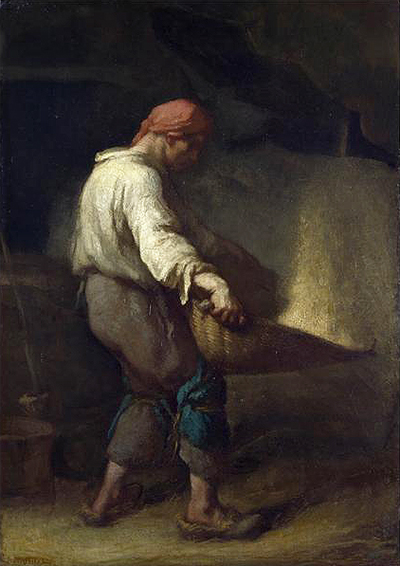This painting, A Winnower, is a variation of work exhibited by Jean Francois at the Salon of 1848, with the same title, and was purchased by Ledru Rollin. Jean abandoned his mythology and picturesque themes and concentrated on his new subject: the peasant. It is an oil on canvas painting done between 1847 and 1848, in France.
The winnower is depicted at work and his movements have been perfectly captured. In the paint, he is seen lifting the winnowing basket with his knees and shaking the grains, disposing the chaff into the air in a cloud of dust, filling the barn, and casts a golden haze over the painting.
In A Winnower, all of Jean's techniques are present here. From his broad simplifications, his localized tones, the rich quality of his colors, and the relationship between the values and most importantly, the presence of great subjects conceived as allegories. The winnower is seen bent in a masterly way.
The paint attracted a lot of publicity when it was exhibited in 1848. It was both praised and attacked by various art critics. As was quoted saying several that his dream was to characterize his type, in Winnower, he created the common man as a laborer. Apart from the use of shadows, his use of primary color allowed the subject to stand out against a filed of dust, earth tone colors in the store. This practice can be traced back to the great renaissance masters like Leonardo da Vinci and Raphael Sanzio.
In Winnower, the sense of movements is emphasized by the wealth of dynamic angles that radiate inwards from its central subject. His clothes are worn out and extremely dirty from long farm labor. Just like in many of his art, the figure represents all of the poverty-stricken peasants in France. However, the figure remains robust, depicting how accustomed he has become to hard farm work.
MIllets legacy lives in many aspects of people's lives, he was an important source of motivation for many people including Vincent Van Gogh. His work was mentioned several in Gogh's letter to his brother Theo. Also, Millets paintings, especially the landscapes served as important points of reference to Claude Monet's paintings.
Among other paintings by Jean Millet include the Portrait of Louis Alexandre of 1841, The abduction of the Sabine, and Going to Work done between 1851 and 1853.




